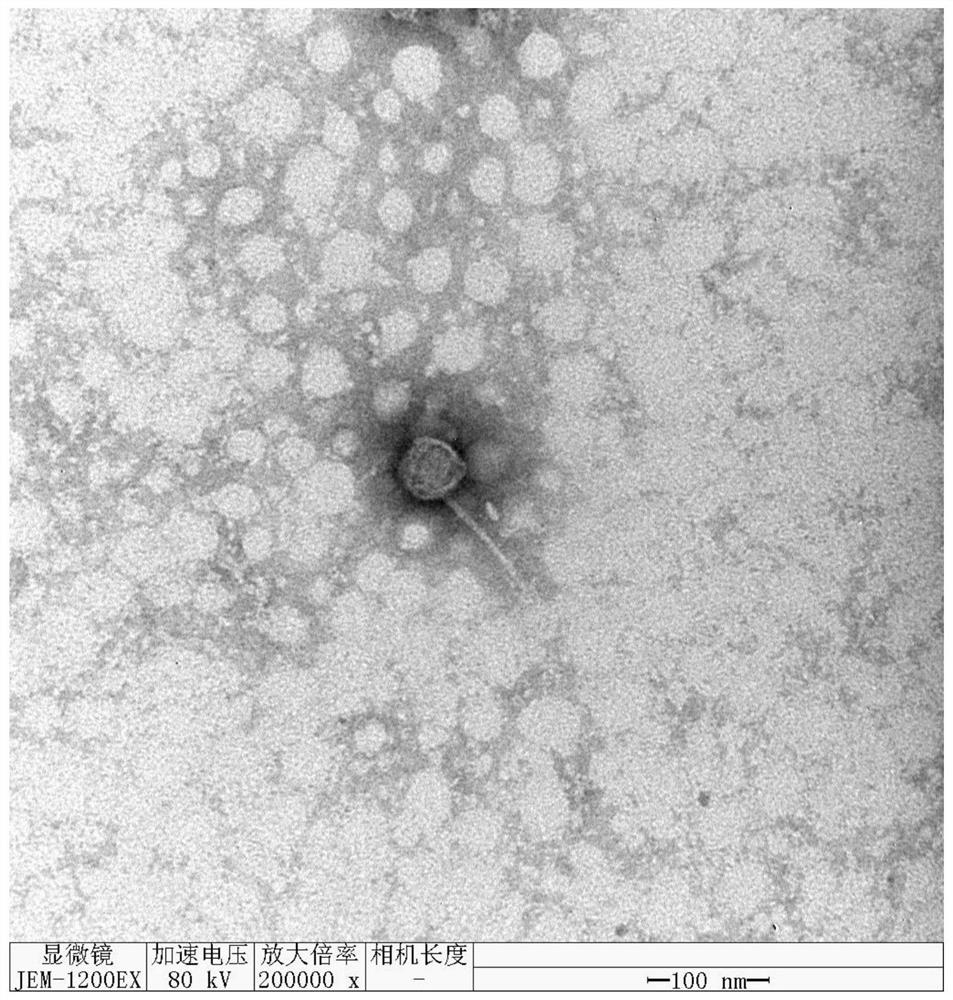Salmonella bacteriophage resistant to antiviral drugs and application of salmonella bacteriophage
An antiviral drug and Salmonella technology, applied to viruses/phages, medical raw materials derived from viruses/phages, phages, etc., can solve the problems of bacterial resistance, untimely treatment, and ineffective medication, etc. Good tolerance and titer stability
- Summary
- Abstract
- Description
- Claims
- Application Information
AI Technical Summary
Problems solved by technology
Method used
Image
Examples
Embodiment 1
[0033] Embodiment 1 Isolation and identification of pathogenic bacteria and bacteriophage
[0034] 1. Isolation and identification of pathogenic Salmonella BS20133
[0035] Sampling from the diseased farm, aseptically take the liver of diseased poultry, streak it on the selective medium (SS agar), culture it at 37°C for 18-24 hours, and form a round, flat, neat edge and smooth surface on the medium Wet black colonies, pick typical colonies and continue to streak and purify 3 times, then pick a single colony and inoculate in 5mL LB broth, shake and culture at 200rpm at 37°C for 8h to obtain a uniform turbid bacterial suspension. Then through 16sRNA molecular identification and serotype identification, it was determined to be pathogenic Salmonella, and one of the strains was named BS20133 and stored in a -80°C refrigerator.
[0036] 2. Isolation and identification of Salmonella phage RDP-SA-20032
[0037] (1) Manure treatment: Take manure from the farm, weigh 5g of chicken man...
Embodiment 2
[0043] Morphological observation of embodiment 2 bacteriophage
[0044] Using phosphotungstic acid negative staining method: drop phage liquid (titer 10 10 pfu / m L) 100μL, put the film side of the copper mesh on the phage droplet, take it off after 10min, let it dry naturally in the air for 2-3min, then drop a drop of 2% phosphotungstic acid (PTA) on the copper mesh The aqueous solution was stained, removed after 10 minutes, dried in the air for 10-15 minutes, observed with an electron microscope, and a clear phage image was selected for photographing. photo by electron microscope figure 1 It can be seen that the bacteriophage has a polyhedral stereosymmetric head, wrapped in nucleic acid, about 65-40nm in diameter, has a tail about 100nm long, has a tail sheath, and the neck is connected to the head and tail. Classified as Tauroviridae.
Embodiment 3
[0045] The mensuration of embodiment 3 phage thermostability
[0046] Dispense the phage stock solution into 50 ml sterilized Erlenmeyer flasks, incubate at 0°C, 30°C, 40°C, 50°C, 60°C, 70°C, 80°C and 90°C for 30min and 60min respectively, and then use After 10-fold serial dilution of normal saline, spread double plates to determine its titer; the results are as follows: figure 2 shown.
[0047] Depend on figure 2 It can be seen that the titer of bacteriophage RDP-SA-20032 is stable within 60°C and remains at 10 11 About pfu / mL; when treated at 60°C for 30min and 60min, the phage titer only decreased by 1 order of magnitude; when incubated at 80°C for 30min and 60min, it was still active, indicating that the phage has good high temperature resistance.
PUM
 Login to View More
Login to View More Abstract
Description
Claims
Application Information
 Login to View More
Login to View More - R&D
- Intellectual Property
- Life Sciences
- Materials
- Tech Scout
- Unparalleled Data Quality
- Higher Quality Content
- 60% Fewer Hallucinations
Browse by: Latest US Patents, China's latest patents, Technical Efficacy Thesaurus, Application Domain, Technology Topic, Popular Technical Reports.
© 2025 PatSnap. All rights reserved.Legal|Privacy policy|Modern Slavery Act Transparency Statement|Sitemap|About US| Contact US: help@patsnap.com



